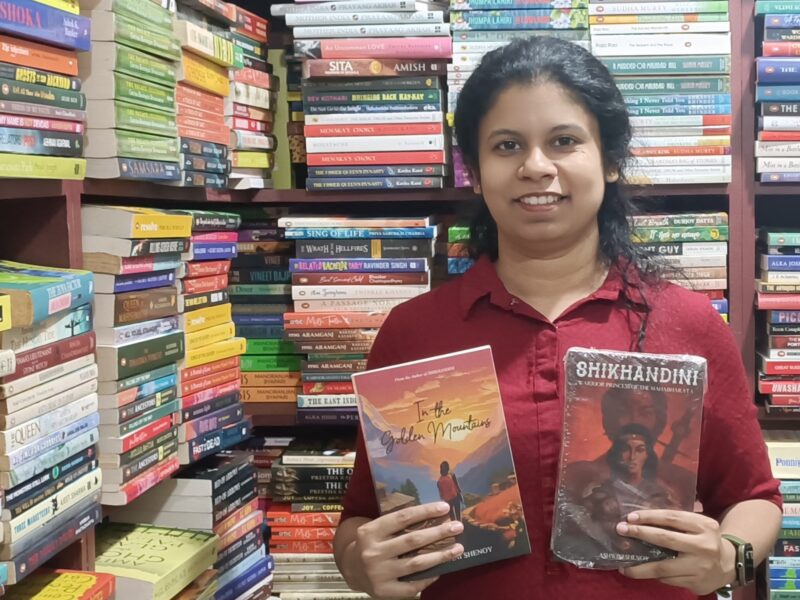This year, I’ve been fortunate enough to be invited to a couple of literary events and have also actively participated in book meetups and book clubs, from which I came home with half a dozen books and a long list of book recommendations to add to my TBR. But I also used this as an opportunity to talk about my books, which my publishers and mentor say is very important. ‘Be shameless and promote,’ is what they advise. I’ve been trying to do that in small groups where I feel comfortable. Whenever I’ve had the courage to do this, I’ve met at least one aspiring writer who wanted to know more about the publishing process — from typing your first word to seeing your book on the shelf. They wanted a realistic picture, specifically from someone who has one book traditionally published before the pandemic, one during, and one after. Trust me, the pandemic has done some serious damage to the publishing industry, which was already quite precarious before.
I often find it difficult to summarize my five-plus years of experience with the publishing industry in just a few words. There’s always this lingering fear that an aspiring writer seeking my advice could have avoided certain unfortunate decisions if I’d only been quick enough to share the right information. That’s why I’m writing this post: To offer guidance(to the best of my knowledge) for those who are just setting foot in the labyrinth that the Indian Publishing Industry is.
There are three main types of publishing: Traditional, Vanity, and Self-publishing. I’ve explained the details about them in my post – ‘How much did I pay to get my book Published.’
However, after the pandemic, I’ve noticed two distinct types of Traditional Publishers emerging:
1. Traditional Publishers with Pan-India Distribution
A traditional publisher is a publishing house that selects, edits, prints and distributes books at its own financial risk, typically offering authors a contract that includes advances and royalties. They handle the production, marketing, and distribution of books, usually selling them through physical bookstores and online retailers. Traditional publishers aim to produce high-quality works that appeal to a wide audience, relying on established industry practices. In return, they keep about 90-92% of the profit they make on the book.
These are often the hardest to break into. While many claim to accept unsolicited manuscripts on their websites, the reality is that most submissions go unread. If you truly want to secure a deal with one of these publishers, you’ll likely need a literary agent. But be cautious — there are many types of agents, and not all are genuine. Do thorough research before deciding whom to approach.
My advice: Read the submission guidelines on each publisher’s website carefully. Prepare your proposal and submit it yourself to each one. This should be your first step. Back in 2019, when I had no idea how the process worked, I submitted the proposal for my debut novel, Shikhandini, to the top 10 traditional publishers in India. The top 4 never responded.
Then, one day, almost a year after I began my submission journey, Leadstart replied, asking for the full manuscript. Even now, five years later, they’re doing a splendid job with my books and have secured a translation contract for my debut.
So, no matter how impossible it may seem, this should be your first approach. Persistence pays off, and even if it takes time, landing a deal with a traditional publisher can open doors for your writing career.
Note: In the past, traditional publishers often paid a signing amount to authors as a way of showing their faith in the book’s potential. However, this may no longer be the case, even with top publishers.
2. Traditional Publishers with Online-Only Distribution
This type of publisher has become more common post-pandemic, typically focusing on distributing books through online platforms like Amazon and Flipkart rather than in physical bookstores. While they may be easier to approach than Pan-India distributors, it’s crucial to carefully weigh the pros and cons, especially when it comes to reach and visibility.
Based on my experience, be very cautious about what you agree to in the contract with this second type of publisher. In 2024 alone, I’ve rejected four so-called traditional publishers because of the following problematic clauses:
- Buyback Requirement
The publisher may require you to buy back a certain number of unsold copies after a specific period post-release.
Example: If they demand you buy back 500 copies, and your book is priced at ₹250 with a 40% author discount (₹150 per copy), you’d be paying ₹75,000 for 500 books. What will you do with so many copies of your book? - Mandatory “Optional” Marketing Packages
Many publishers offer a full-fledged marketing package, often costing lakhs of rupees, which they claim is optional but, in reality, is usually mandatory. - One-Time Publishing Fee
Some publishers charge a one-time publishing fee. If you’re considering paying for this, you might as well self-publish and retain more control over your book. - Marketing Budget Requirement
Some contracts ask how much you, as the author, are willing to spend on marketing after the book is released. Others may require collaboration with the publisher’s sister company for marketing, often with steep fees. My advice: run in the opposite direction. Don’t even bother asking for clarification—this is a clear sign of a vanity-style model.
Note: Bookstores charge significant fees to keep your book on the shelves, which is why many small traditional publishers cannot afford it unless they know they’ll see a substantial return. Only the top five or six traditional publishers with Pan-India distribution can usually afford to take on this risk.
Also note that sometimes even the biggest publishers might offer you a vanity publishing contract disguised as a traditional one, especially if you’re a desperate author wanting to see your debut in print as early as possible. Don’t fall for the brand name. Vanity is vanity, even if the name is prestigious. Remember, a genuine traditional publisher will never ask you to pay for anything. I recently encountered some once-reputable traditional publishers that asked authors for editing fees, cover design costs, and even an Amazon seller account maintenance fee! If you see this, run!



